92448 UTS Nursing: Nurse to Patient Ratio Presentation Analysis
VerifiedAdded on 2022/11/11
|6
|1221
|231
Presentation
AI Summary
This presentation, prepared for a nursing course, focuses on the critical importance of the nurse-to-patient ratio in healthcare settings. The presentation emphasizes the need for appropriate staffing levels to ensure patient safety and a healthy work environment for nurses. It explores how maintaining optimal nurse-to-patient ratios can prevent medical errors, reduce patient mortality, and improve overall patient satisfaction. The presentation also highlights the role of effective clinical leadership in establishing and maintaining safe staffing practices, including the implementation of formal staffing plans, addressing staff turnover, and utilizing technology to improve workflow. Furthermore, the presentation underscores the negative consequences of inadequate nurse staffing, such as increased patient falls, infections, and medication errors, and provides evidence-based research supporting the positive impact of appropriate nurse-to-patient ratios on patient outcomes. The presentation concludes by advocating for policies and strategies that prioritize patient safety through optimal staffing models and a supportive work environment.
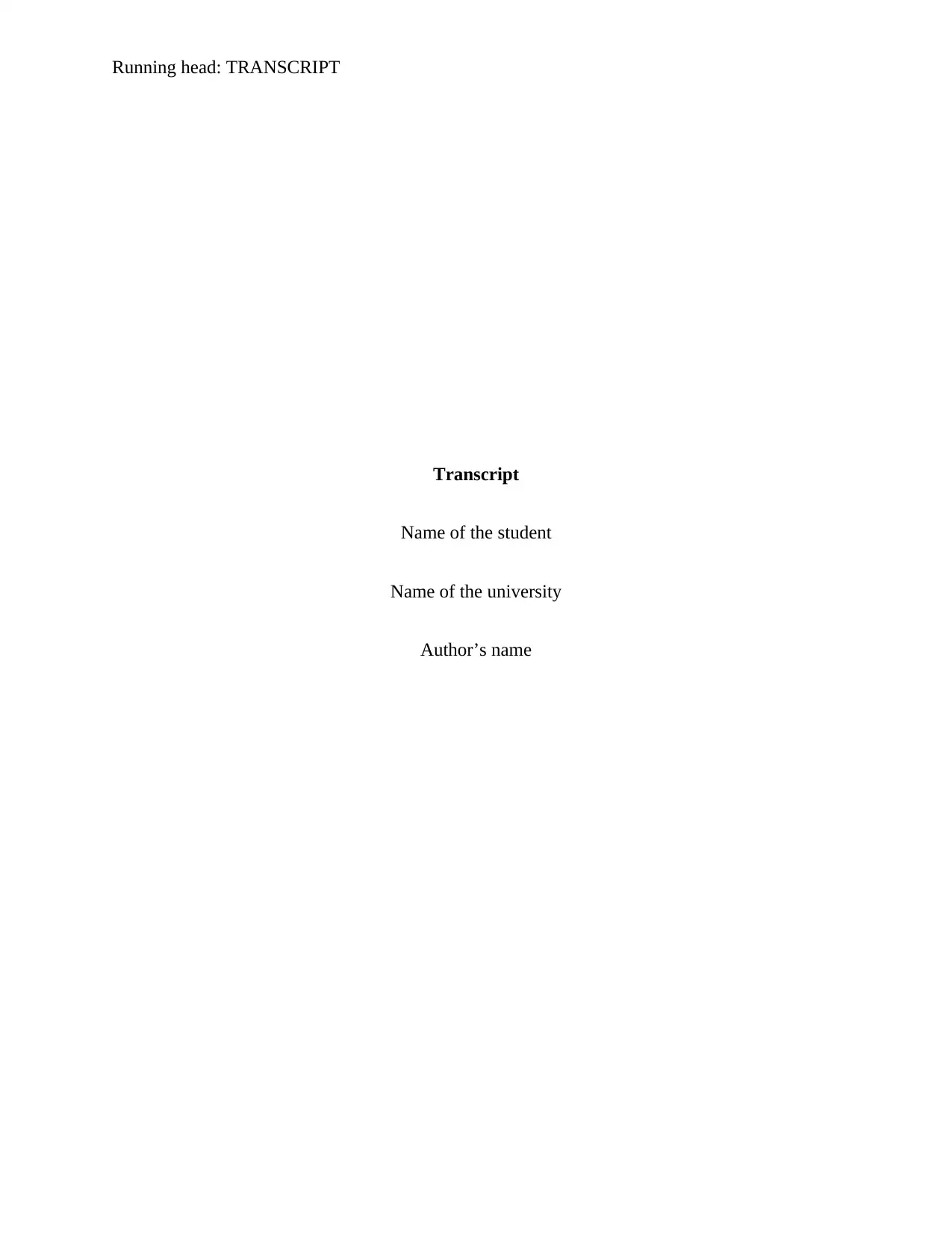
Running head: TRANSCRIPT
Transcript
Name of the student
Name of the university
Author’s name
Transcript
Name of the student
Name of the university
Author’s name
Paraphrase This Document
Need a fresh take? Get an instant paraphrase of this document with our AI Paraphraser
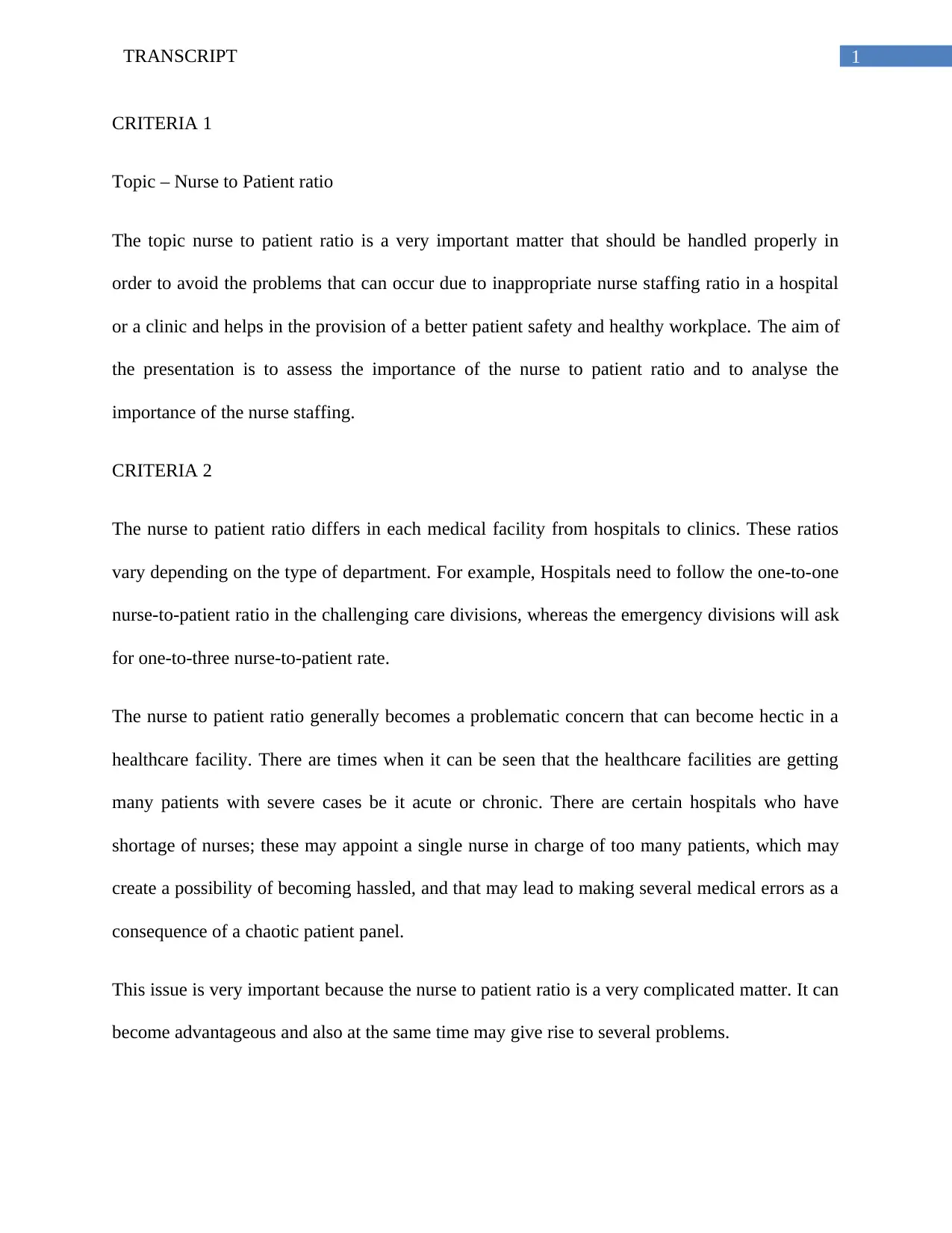
1TRANSCRIPT
CRITERIA 1
Topic – Nurse to Patient ratio
The topic nurse to patient ratio is a very important matter that should be handled properly in
order to avoid the problems that can occur due to inappropriate nurse staffing ratio in a hospital
or a clinic and helps in the provision of a better patient safety and healthy workplace. The aim of
the presentation is to assess the importance of the nurse to patient ratio and to analyse the
importance of the nurse staffing.
CRITERIA 2
The nurse to patient ratio differs in each medical facility from hospitals to clinics. These ratios
vary depending on the type of department. For example, Hospitals need to follow the one-to-one
nurse-to-patient ratio in the challenging care divisions, whereas the emergency divisions will ask
for one-to-three nurse-to-patient rate.
The nurse to patient ratio generally becomes a problematic concern that can become hectic in a
healthcare facility. There are times when it can be seen that the healthcare facilities are getting
many patients with severe cases be it acute or chronic. There are certain hospitals who have
shortage of nurses; these may appoint a single nurse in charge of too many patients, which may
create a possibility of becoming hassled, and that may lead to making several medical errors as a
consequence of a chaotic patient panel.
This issue is very important because the nurse to patient ratio is a very complicated matter. It can
become advantageous and also at the same time may give rise to several problems.
CRITERIA 1
Topic – Nurse to Patient ratio
The topic nurse to patient ratio is a very important matter that should be handled properly in
order to avoid the problems that can occur due to inappropriate nurse staffing ratio in a hospital
or a clinic and helps in the provision of a better patient safety and healthy workplace. The aim of
the presentation is to assess the importance of the nurse to patient ratio and to analyse the
importance of the nurse staffing.
CRITERIA 2
The nurse to patient ratio differs in each medical facility from hospitals to clinics. These ratios
vary depending on the type of department. For example, Hospitals need to follow the one-to-one
nurse-to-patient ratio in the challenging care divisions, whereas the emergency divisions will ask
for one-to-three nurse-to-patient rate.
The nurse to patient ratio generally becomes a problematic concern that can become hectic in a
healthcare facility. There are times when it can be seen that the healthcare facilities are getting
many patients with severe cases be it acute or chronic. There are certain hospitals who have
shortage of nurses; these may appoint a single nurse in charge of too many patients, which may
create a possibility of becoming hassled, and that may lead to making several medical errors as a
consequence of a chaotic patient panel.
This issue is very important because the nurse to patient ratio is a very complicated matter. It can
become advantageous and also at the same time may give rise to several problems.

2TRANSCRIPT
• The patient safety act states that the obligatory nurse ratios will help in enhancing
the patient care quality because it has the idea that nurses will diverge their care
among fewer patients; however there many critics that states that it can restrict the
patient care access.
• Also there is a chance that, if a hospital or a clinic permits one nurse to a certain
number of patients, then it may limit the hospital’s patient quantity.
• The significance of effective clinical leadership in guaranteeing a high quality
health care system that unfailingly delivers safe and effective care. Effective
clinical leadership is a necessity of hospital care, with system performance,
attainment of health reform goals, timely care provision, and is an essential factor
of the healthcare system.
CRITERIA 3
Nurse to patient ratio is really very important as not maintaining the ratio will cause unnecessary
deaths, grievance, and will form a negative surrounding the patients’ family and also the
healthcare members. All such impacts can be prevented in several ways and effective leadership
is a primary role for prevention of such impacts and is very important for nurses at all stages of
the nursing field. Variety in the policies and initiatives mean that the nursing profession has a
progressing impact on all the phases of healthcare distribution. Medical staffs should be well
aware and much capable in order to apply this leadership skill evidently and positively. Efficient
leaders are a necessity for solving difficult problems, maintaining the group efficiency and
improve group identification. The effective leader should be dynamic, passionate, have a
motivational impact on other members, and they should be solution-focused and keep on
• The patient safety act states that the obligatory nurse ratios will help in enhancing
the patient care quality because it has the idea that nurses will diverge their care
among fewer patients; however there many critics that states that it can restrict the
patient care access.
• Also there is a chance that, if a hospital or a clinic permits one nurse to a certain
number of patients, then it may limit the hospital’s patient quantity.
• The significance of effective clinical leadership in guaranteeing a high quality
health care system that unfailingly delivers safe and effective care. Effective
clinical leadership is a necessity of hospital care, with system performance,
attainment of health reform goals, timely care provision, and is an essential factor
of the healthcare system.
CRITERIA 3
Nurse to patient ratio is really very important as not maintaining the ratio will cause unnecessary
deaths, grievance, and will form a negative surrounding the patients’ family and also the
healthcare members. All such impacts can be prevented in several ways and effective leadership
is a primary role for prevention of such impacts and is very important for nurses at all stages of
the nursing field. Variety in the policies and initiatives mean that the nursing profession has a
progressing impact on all the phases of healthcare distribution. Medical staffs should be well
aware and much capable in order to apply this leadership skill evidently and positively. Efficient
leaders are a necessity for solving difficult problems, maintaining the group efficiency and
improve group identification. The effective leader should be dynamic, passionate, have a
motivational impact on other members, and they should be solution-focused and keep on
⊘ This is a preview!⊘
Do you want full access?
Subscribe today to unlock all pages.

Trusted by 1+ million students worldwide
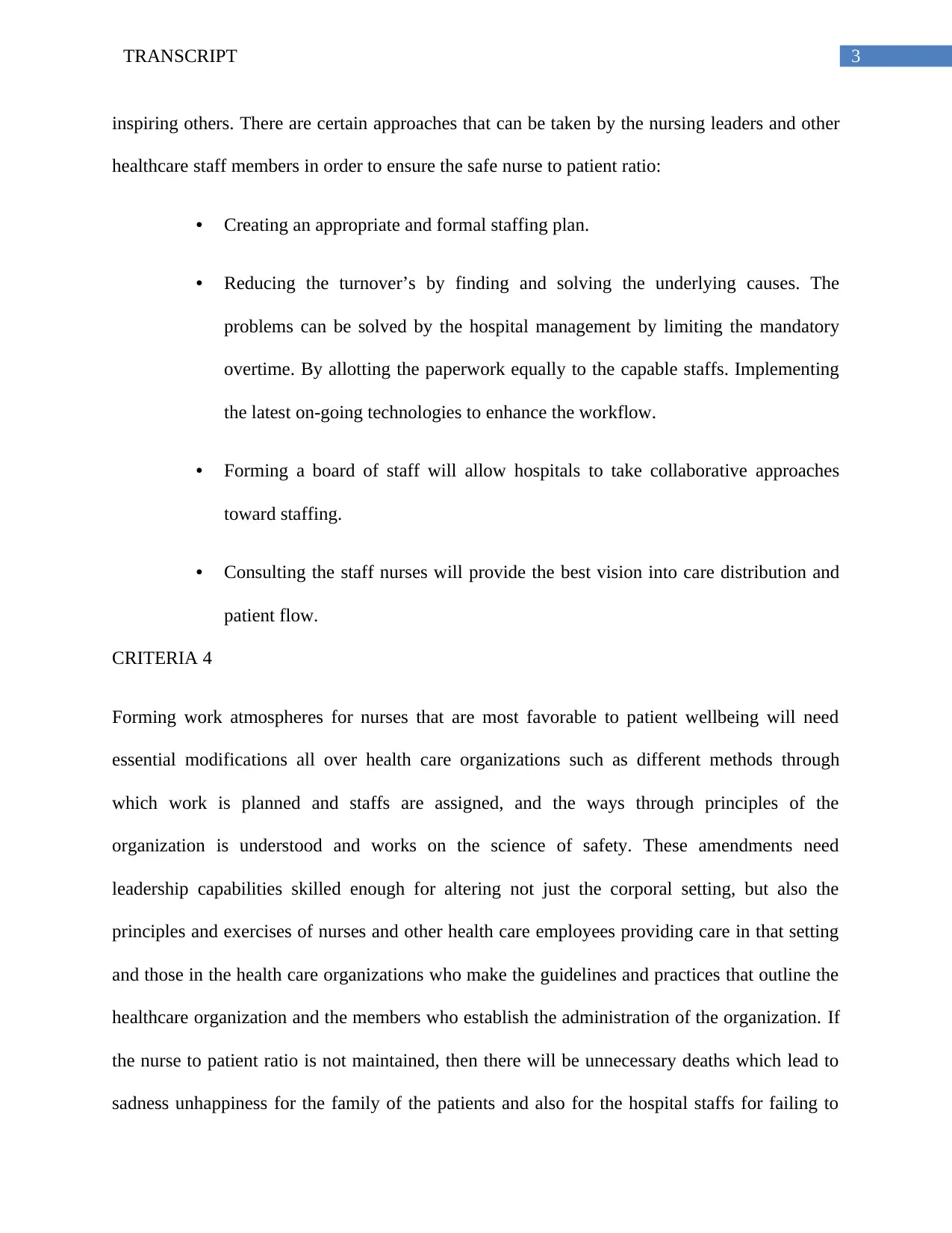
3TRANSCRIPT
inspiring others. There are certain approaches that can be taken by the nursing leaders and other
healthcare staff members in order to ensure the safe nurse to patient ratio:
• Creating an appropriate and formal staffing plan.
• Reducing the turnover’s by finding and solving the underlying causes. The
problems can be solved by the hospital management by limiting the mandatory
overtime. By allotting the paperwork equally to the capable staffs. Implementing
the latest on-going technologies to enhance the workflow.
• Forming a board of staff will allow hospitals to take collaborative approaches
toward staffing.
• Consulting the staff nurses will provide the best vision into care distribution and
patient flow.
CRITERIA 4
Forming work atmospheres for nurses that are most favorable to patient wellbeing will need
essential modifications all over health care organizations such as different methods through
which work is planned and staffs are assigned, and the ways through principles of the
organization is understood and works on the science of safety. These amendments need
leadership capabilities skilled enough for altering not just the corporal setting, but also the
principles and exercises of nurses and other health care employees providing care in that setting
and those in the health care organizations who make the guidelines and practices that outline the
healthcare organization and the members who establish the administration of the organization. If
the nurse to patient ratio is not maintained, then there will be unnecessary deaths which lead to
sadness unhappiness for the family of the patients and also for the hospital staffs for failing to
inspiring others. There are certain approaches that can be taken by the nursing leaders and other
healthcare staff members in order to ensure the safe nurse to patient ratio:
• Creating an appropriate and formal staffing plan.
• Reducing the turnover’s by finding and solving the underlying causes. The
problems can be solved by the hospital management by limiting the mandatory
overtime. By allotting the paperwork equally to the capable staffs. Implementing
the latest on-going technologies to enhance the workflow.
• Forming a board of staff will allow hospitals to take collaborative approaches
toward staffing.
• Consulting the staff nurses will provide the best vision into care distribution and
patient flow.
CRITERIA 4
Forming work atmospheres for nurses that are most favorable to patient wellbeing will need
essential modifications all over health care organizations such as different methods through
which work is planned and staffs are assigned, and the ways through principles of the
organization is understood and works on the science of safety. These amendments need
leadership capabilities skilled enough for altering not just the corporal setting, but also the
principles and exercises of nurses and other health care employees providing care in that setting
and those in the health care organizations who make the guidelines and practices that outline the
healthcare organization and the members who establish the administration of the organization. If
the nurse to patient ratio is not maintained, then there will be unnecessary deaths which lead to
sadness unhappiness for the family of the patients and also for the hospital staffs for failing to
Paraphrase This Document
Need a fresh take? Get an instant paraphrase of this document with our AI Paraphraser
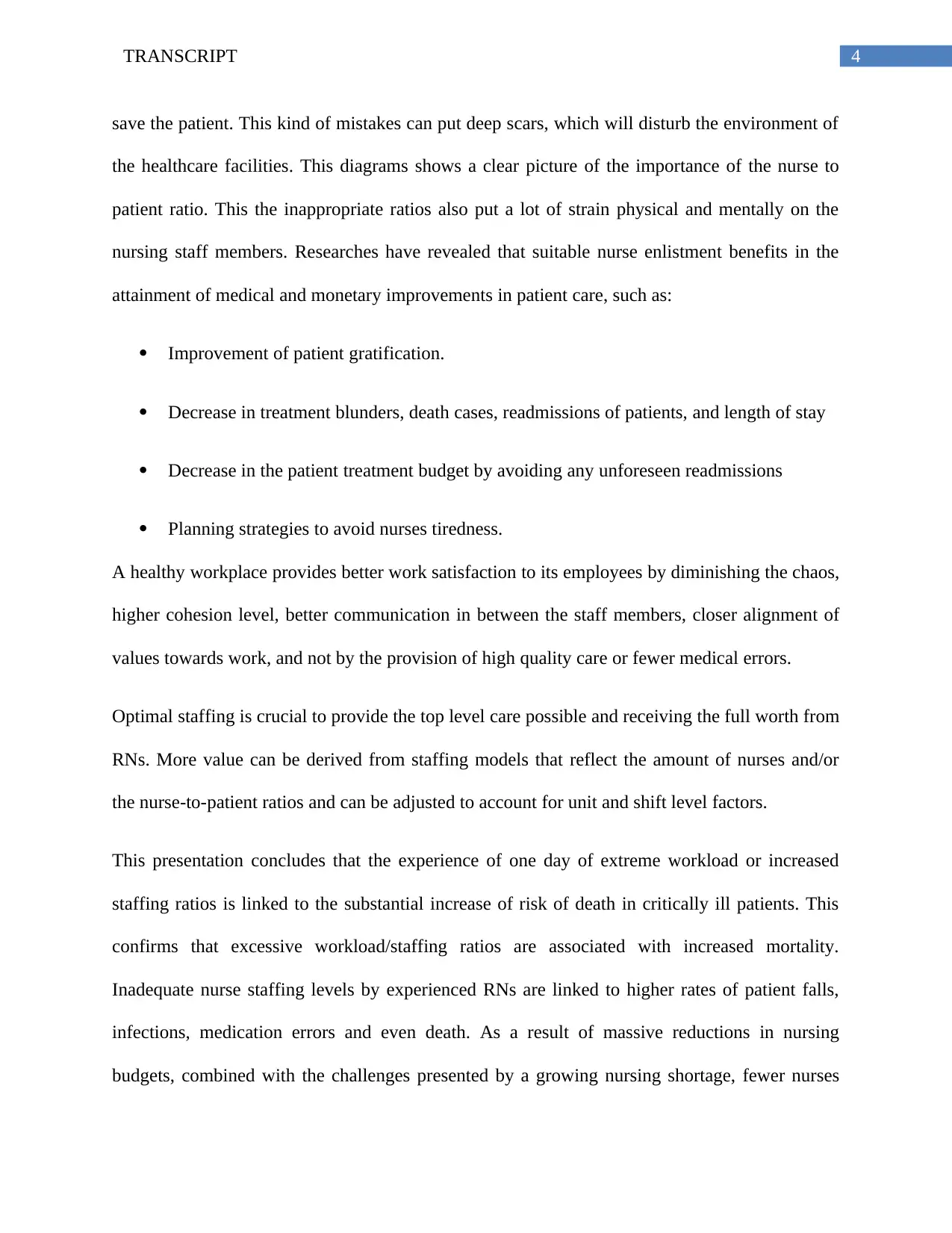
4TRANSCRIPT
save the patient. This kind of mistakes can put deep scars, which will disturb the environment of
the healthcare facilities. This diagrams shows a clear picture of the importance of the nurse to
patient ratio. This the inappropriate ratios also put a lot of strain physical and mentally on the
nursing staff members. Researches have revealed that suitable nurse enlistment benefits in the
attainment of medical and monetary improvements in patient care, such as:
Improvement of patient gratification.
Decrease in treatment blunders, death cases, readmissions of patients, and length of stay
Decrease in the patient treatment budget by avoiding any unforeseen readmissions
Planning strategies to avoid nurses tiredness.
A healthy workplace provides better work satisfaction to its employees by diminishing the chaos,
higher cohesion level, better communication in between the staff members, closer alignment of
values towards work, and not by the provision of high quality care or fewer medical errors.
Optimal staffing is crucial to provide the top level care possible and receiving the full worth from
RNs. More value can be derived from staffing models that reflect the amount of nurses and/or
the nurse-to-patient ratios and can be adjusted to account for unit and shift level factors.
This presentation concludes that the experience of one day of extreme workload or increased
staffing ratios is linked to the substantial increase of risk of death in critically ill patients. This
confirms that excessive workload/staffing ratios are associated with increased mortality.
Inadequate nurse staffing levels by experienced RNs are linked to higher rates of patient falls,
infections, medication errors and even death. As a result of massive reductions in nursing
budgets, combined with the challenges presented by a growing nursing shortage, fewer nurses
save the patient. This kind of mistakes can put deep scars, which will disturb the environment of
the healthcare facilities. This diagrams shows a clear picture of the importance of the nurse to
patient ratio. This the inappropriate ratios also put a lot of strain physical and mentally on the
nursing staff members. Researches have revealed that suitable nurse enlistment benefits in the
attainment of medical and monetary improvements in patient care, such as:
Improvement of patient gratification.
Decrease in treatment blunders, death cases, readmissions of patients, and length of stay
Decrease in the patient treatment budget by avoiding any unforeseen readmissions
Planning strategies to avoid nurses tiredness.
A healthy workplace provides better work satisfaction to its employees by diminishing the chaos,
higher cohesion level, better communication in between the staff members, closer alignment of
values towards work, and not by the provision of high quality care or fewer medical errors.
Optimal staffing is crucial to provide the top level care possible and receiving the full worth from
RNs. More value can be derived from staffing models that reflect the amount of nurses and/or
the nurse-to-patient ratios and can be adjusted to account for unit and shift level factors.
This presentation concludes that the experience of one day of extreme workload or increased
staffing ratios is linked to the substantial increase of risk of death in critically ill patients. This
confirms that excessive workload/staffing ratios are associated with increased mortality.
Inadequate nurse staffing levels by experienced RNs are linked to higher rates of patient falls,
infections, medication errors and even death. As a result of massive reductions in nursing
budgets, combined with the challenges presented by a growing nursing shortage, fewer nurses
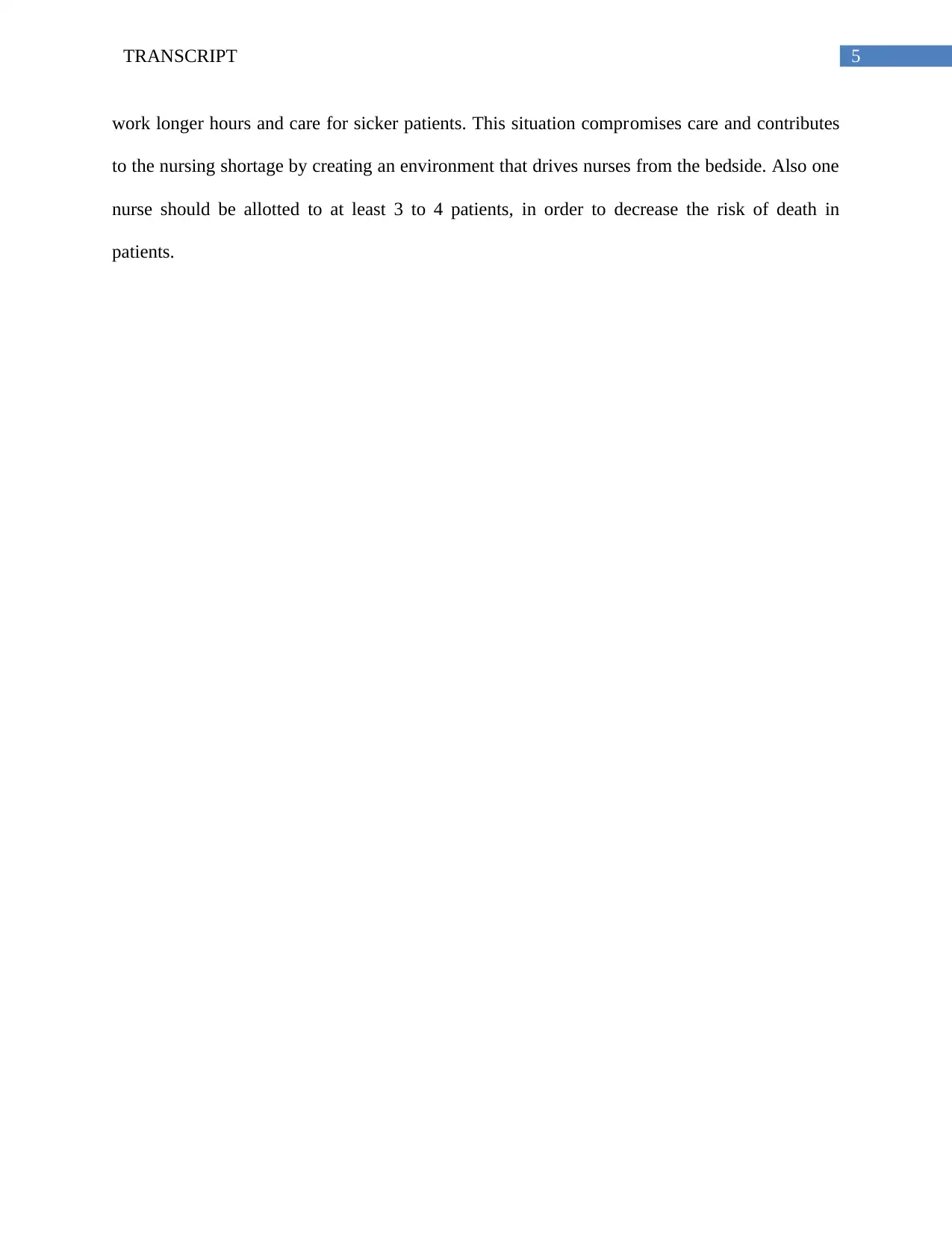
5TRANSCRIPT
work longer hours and care for sicker patients. This situation compromises care and contributes
to the nursing shortage by creating an environment that drives nurses from the bedside. Also one
nurse should be allotted to at least 3 to 4 patients, in order to decrease the risk of death in
patients.
work longer hours and care for sicker patients. This situation compromises care and contributes
to the nursing shortage by creating an environment that drives nurses from the bedside. Also one
nurse should be allotted to at least 3 to 4 patients, in order to decrease the risk of death in
patients.
⊘ This is a preview!⊘
Do you want full access?
Subscribe today to unlock all pages.

Trusted by 1+ million students worldwide
1 out of 6
Related Documents
Your All-in-One AI-Powered Toolkit for Academic Success.
+13062052269
info@desklib.com
Available 24*7 on WhatsApp / Email
![[object Object]](/_next/static/media/star-bottom.7253800d.svg)
Unlock your academic potential
Copyright © 2020–2025 A2Z Services. All Rights Reserved. Developed and managed by ZUCOL.





